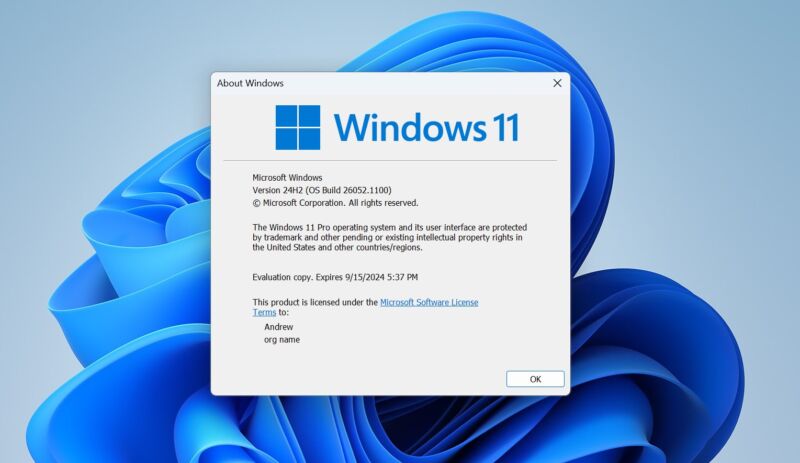The next major release of Windows isn’t due until the end of the year, but it looks like Microsoft is getting an early start. New Windows Insider builds released to the Canary and Dev channels both roll their version numbers to “24H2,” indicating that they’re the earliest builds of what Microsoft will eventually release to all Windows users sometime this fall.
New features in 24H2 include a smattering of things Microsoft has already been testing in public since the big batch of new features that dropped last September, plus a handful of new things. The biggest new one is the addition of Sudo for Windows, a version of a Linux/Unix terminal command that first broke cover in a preview build earlier this month. The new build also includes better support for hearing aids, support for creating 7-zip and TAR archives in File Explorer, an energy-saving mode, and new changes to the SMB protocol. This build also removes both the WordPad and the Tips apps.
Some of these features may be released to all Windows 11 users before the end of the year. During the Windows 11 era, it’s been Microsoft’s practice to drop new features in several small batches throughout the year.
The early change to the 24H2 numbering is a departure from last year, where Windows 11 23H2 didn’t appear publicly until the end of October. And even then, it was mostly just an update that rolled over the version number and Microsoft’s support clock for software updates—most of its “new” features had actually rolled out to PCs running Windows 11 22H2 the month before.
There are some signs that this update will be fairly significant in scope. In addition to all the features Microsoft listed, there are signs that the company is revising things like the Windows setup process that you go through when installing the OS from scratch. The current setup screens have remained essentially unchanged since Windows Vista in 2006, with only light and mostly cosmetic tweaks since then (and even in the redesigned version, window borders are still done in the Vista/7 style).
Logistically, this initial build of Windows 11 24H2 allows Windows Insider testers in the most unstable Canary channel to switch to the less unstable Dev channel without completely reinstalling Windows. Eventually, this… window will close, and the Canary channel will jump into a new series of build numbers.
Whither Windows 12?
Some news outlets and users have taken this update’s announcement as proof that the rumored “Windows 12” won’t happen this year. The existence of Windows 12, largely inferred based on rumors and stray statements from PC makers and analysts, has never been officially confirmed or denied by Microsoft.
A 24H2 update does suggest that Windows 11 will continue on for at least another year, but it doesn’t necessarily preclude a Windows 12 launch this year. Windows 10 received a 21H2 update the year Windows 11 came out and a 22H2 update the year after that (not that either came with significant new features). Microsoft could decide to rename the upcoming feature update on relatively short notice—like it originally did with Windows 11, which began as a design overhaul for Windows 10. Windows 12 might happen, or it might not, but I wouldn’t take this Windows 11 24H2 update as decisive evidence one way or the other.
AI was said to be a major focus for the hypothetical Windows 12, as it has been for the last few major Windows 11 updates. Trendforce went as far as to say that “AI PCs” running “the next generation of Windows” would need a “baseline” of 16GB of RAM, though when asked about this, a Microsoft representative told us that the company “doesn’t comment on rumors and speculation.” Trendforce also said that these AI PCs would need neural processing units (NPUs) that met certain performance standards.
To date, Microsoft hasn’t imposed any specific system requirements for Copilot or Windows’ other generative AI features, aside from 4GB RAM and 720p screen requirements for the Windows 10 version of Copilot, but this could change if more of Windows’ AI features begin relying on local processing rather than cloud processing.
Listing image by Microsoft
